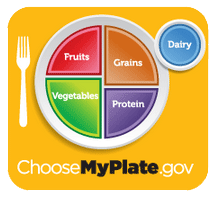Curbing overeating this holiday
It’s possible to celebrate Christmas, New Year’s Eve, or any holiday—without going overboard on sweet treats and calorie-laden food and beverages. Here are a few simple strategies to help support you in eating healthy at your holiday celebrations.
Drink plenty of water
Drinking water will help you stay hydrated and feel full. Additionally, by choosing water, you’ll be avoiding empty liquid calories. Remember, that 12 oz can of Coke contains 140 calories and 10 teaspoons of sugar—skip it and you’ll save room for dessert!
Learn more: How much sugar do you drink?
Eat vegetables first
High in fiber, vegetables also help us feel full and add few calories. Snack on some raw carrots, celery, pepper strips, broccoli, cucumbers, or snap peas before you leave home, or offer to bring a raw vegetable tray for an appetizer. If you’re cooking, crunching on fiber- and water-rich vegetables as you prep the meal can help curb the temptation to sample everything.

Choose a small plate
We eat less when using small plates, in part because the plate looks and feels full with less food on it. Modern dinnerware is 25% larger than it was a century ago, and American plate sizes have grown 3-4 inches since the 1960s alone! Choose a plate that is 7-9 inches in diameter, if possible.
Bonus: if a small red plate is an option, choose it. Some research suggests that people eat less on red plates. Don’t rest all your hopes on this trick, but if it’s available, why not try it?
Enjoy smaller portions
Eating healthy isn’t about depriving yourself of your favorite foods or missing out on the celebration. It’s about being mindful of what you put into your body. So you don’t have to skip the pumpkin pie, but you can take a smaller portion than Grandma usually cuts. If side dishes are your weakness, place small spoonfuls on your plate instead of heaping helpings.

Fill your plate intentionally
As with any meal, aim to fill half your plate with fruits and vegetables, a quarter of it with plant-based grains (whole grains when possible), and the last quarter with protein. It might help to walk around the buffet table first to see what’s available, and keep the Choose My Plate template in mind.
Wait before refilling
Scientists say it takes our brain 20 minutes to process that our body is “full.” So fill your plate and eat, then wait before deciding if you need seconds. When you’re grazing on appetizers, it can be even more difficult to gauge fullness, so take the time to pay attention to your body.
Keep moving
Stand up after you finish that first plate of food and move around—walking after you eat is good for digestion and decreases blood sugar. Even moving around the kitchen, or standing to talk, or circulating among guests will help.

Get moving tip: Make physical activity part of your family’s tradition. See our tips for a do-it-yourself “Gobble Wobble” for extra family fun!
Eat Healthy at the Office, too
Is your workplace unintentionally sabotaging your health? Full-time employees consume half or more of their daily calories while at work, so it’s important to support healthy choices at the job site. Learn how to support employee wellness—and reduce costs—in our guide, 4 Strategies to Increase Healthy Eating in the Workplace.

Topics: Healthy Celebrations, Healthy Eating
Subscribe for more
Want more ideas for healthy schools, workplaces, child care providers, and families? Subscribe to our blog for weekly tips delivered right to your inbox!
The Social Determinants of Health NEXT »
New Year's Resolution Made Easy
